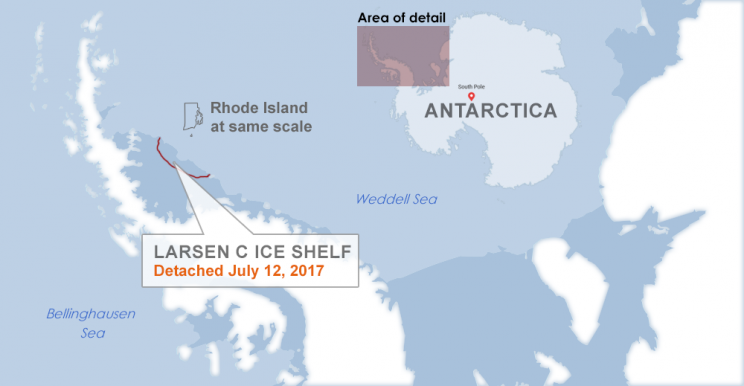Iceberg nearly twice the size of Rhode Island breaks off Antarctica
A large portion of an ice shelf that was said to be “hanging by a thread” last month has broken off from the Antarctic mainland, creating one of the world’s largest icebergs, according to a Wednesday report by British Antarctic research group Project Midas.
The iceberg, which is estimated to have separated from the Larsen C ice shelf between Monday and Wednesday, will be named A68. It weighs 1 trillion tons and contains twice the volume of water held in Lake Erie, the report said. It is measured at 5,800 square kilometers, making it nearly twice the size of Rhode Island.
The ice shelf’s calving has been expected for some time. Project Midas wrote that it was “watching with bated breath” after the rift separating the iceberg from the main shelf grew 11 miles in six days in late May. At the time, Adrian Luckman, lead investigator of Project Midas, wrote that the separation of the ice shelf would “fundamentally change the landscape of the Antarctic Peninsula.”
The initial rift branched off several times, but only one iceberg can be seen at this time, Luckman told the Guardian.

“The iceberg is one of the largest recorded and its future progress is difficult to predict,” Luckman said in a statement on the group’s website. “It may remain in one piece but is more likely to break into fragments. Some of the ice may remain in the area for decades, while parts of the iceberg may drift north into warmer waters.”
Dr. Martin O’Leary, a glaciologist at Swansea University and a Midas member, said though the calving was not apparently tied to manmade climate change, it was nevertheless concerning.
“Although this is a natural event, and we’re not aware of any link to human-induced climate change, this puts the ice shelf in a very vulnerable position,” he said on the website. “This is the furthest back that the ice front has been in recorded history. We’re going to be watching very carefully for signs that the rest of the shelf is becoming unstable.”

Rising sea levels endanger heavily populated cities such as New York, San Francisco, New Orleans and Miami, and are predicted to cause 13.1 million Americans to relocate from coastal areas by 2100.
This iceberg will not “immediately” influence sea levels, according to Project Midas, but if Larsen C continues to disintegrate, sea levels could be affected by glaciers flowing off the land behind the ice shelf into the ocean.
The scientific community first became concerned about the possibility of the Larsen C disintegrating after two nearby ice shelves — Larsen A and Larsen B — disappeared in 1995 and 2002, respectively.
“In the ensuing months and years, the ice shelf could either gradually regrow, or may suffer further calving events which may eventually lead to collapse — opinions in the scientific community are divided,” Luckman said. “Our models say it will be less stable, but any future collapse remains years or decades away.”

_____
Read more from Yahoo News:


